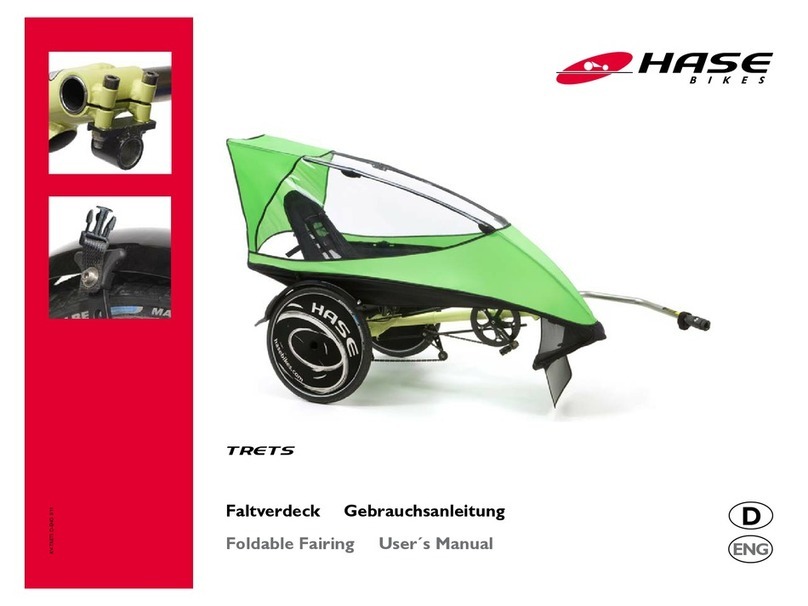FV-D-ENG 1/12 1
Inhalt Contents
Scope of delivery and optional Accessories ............................2
Safety information .....................................................................3
Read User’s Manual......................................................................................... 3
Symbols used for notes and warnings......................................................... 3
Intended use...................................................................................................... 3
Mounting and adjustment............................................................................... 3
Use of the Rain Poncho.................................................................................. 3
Riding in windy conditions............................................................................. 4
Parking in windy conditions........................................................................... 4
Being visible for others................................................................................... 4
Caution when opening the Foldable Fairing .............................................. 4
Before each ride............................................................................................... 4
Technical condition ......................................................................................... 4
Mounting the fairing mounts ....................................................5
Mounting the fairing mounts: Kettwiesel, Klimax, and Trix .................. 5
Mounting the side mounts ...................................................................................5
Mounting the front mount ..........................................................................................6
Mounting the long fender to a 20” wheel................................................................7
Mounting a second fender for the 16” wheel (Trix and Lepus Comfort) .......8
Mounting the splash guard ..........................................................................................9
Mounting the Fairing Bag .......................................................................................... 10
Mounting the fairing mount: Lepus............................................................11
Mounting the side mounts........................................................................................ 11
Mounting the front mount ....................................................................................... 11
Mounting the long fender for a 20” wheel........................................................... 11
Mounting a second fender for a 16” wheel ......................................................... 11
Mounting the fairing mount: Pino...............................................................12
Mounting the side mounts........................................................................................ 12
Mounting the front mount ....................................................................................... 12
Mounting the headlight mount to the Pino ......................................................... 14
Riding with the Foldable Fairing.............................................15
Mounting the Foldable Fairing.....................................................................15
Adjusting the Foldable Fairing.....................................................................18
Adjusting wind deflector height..................................................................19
Mounting and dismounting .........................................................................21
Attaching the Rain Poncho ..........................................................................22
Adapting the Rain Poncho for smaller riders..........................................24
Removing the Foldable Fairing....................................................................27
Cleaning and storing the Foldable Fairing ................................................27
Replacement parts...................................................................28
Front mount....................................................................................................28
Side-mount parts for Kettwiesel, Klimax, and Trix...............................29
Side-mount parts for Lepus and Pino........................................................30
Frame joint, locking plate, rearview mirror.............................................31
Headlight Mount.............................................................................................32
Appendix for dealers................................................................34
Drilling hole in head tube ...........................................................................34
Drilling template.............................................................................................35
Lieferumfang und Zubehör .......................................................2
Sicherheitshinweise....................................................................3
Gebrauchsanweisung beachten..................................................................... 3
Verwendete Symbole und Warnungen....................................................... 3
Verwendungszweck......................................................................................... 3
Montage und Einstellung................................................................................. 3
Benutzung des Regenponchos ...................................................................... 3
Fahren bei Wind............................................................................................... 4
Parken bei Wind .............................................................................................. 4
Sichtbar sein für andere.................................................................................. 4
Öffnen des Faltverdecks................................................................................. 4
Bevor Sie losfahren.......................................................................................... 4
Technischer Zustand....................................................................................... 4
Montage ......................................................................................5
Montage am Kettwiesel, Klimax und Trix.................................................. 5
Seitliche Befestigung montieren .........................................................................5
Vordere Befestigung montieren .............................................................................6
Langes Schutzblech für 20“ Rad montieren ............................................................7
Zweites Schutzblech für 16“ Rad montieren (Trix und Lepus Comfort)........8
Spritzschutz montieren................................................................................................9
Tasche anbringen........................................................................................................ 10
Montage am Lepus.........................................................................................11
Seitliche Befestigung montieren.............................................................................. 11
Vordere Befestigung montieren.............................................................................. 11
Langes Schutzblech für 20“ Rad montieren ......................................................... 11
Langes Schutzblech für 16“ Rad montieren ......................................................... 11
Montage am Pino ...........................................................................................12
Seitliche Befestigung montieren.............................................................................. 12
Vordere Befestigung montieren.............................................................................. 12
Lampenhalterung an Pino montieren..................................................................... 14
Rund ums Fahren .....................................................................15
Faltverdeck anbringen...................................................................................15
Ausrichten des Faltverdecks........................................................................18
Höhe der Windabrisskante einstellen.......................................................19
Ein- und Ausstiegen.......................................................................................21
Regenponcho anbringen...............................................................................22
Regenponcho an kleine Personen anpassen ............................................24
Faltverdeck abnehmen..................................................................................27
Reinigung und Lagerung des Faltverdecks................................................27
Ersatzteile.................................................................................28
Vordere Befestigung......................................................................................28
Seitliche Befestigung Kettwiesel, Klimax, Trix........................................29
Seitliche Befestigung Lepus, Pino................................................................30
Stangengelenk, Rastblech, Rückspiegel......................................................31
Lampenhalterung Pino ..................................................................................32
Anhang für Händler .................................................................34
Bohrung im Steuerrohr anbringen ............................................................34
Bohrschablone................................................................................................35




























